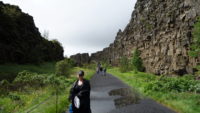 One thing that Iceland teaches is that rock can split when enough pressure is applied. Meredith wanted to see the area near Reykjavik called the Golden Circle, which has several popular sights along the somewhat circular route. The first place we stopped today was Pingvellir, a national park. Pingvellir is known for two things – it is where the North American plate and the European plates are diverging, leaving the Pingvellir valley between the two cliff faces of the continental plates. Pingvellir was also the home of the Alpingi, Iceland’s first parliament, which started meeting in the 900s.
One thing that Iceland teaches is that rock can split when enough pressure is applied. Meredith wanted to see the area near Reykjavik called the Golden Circle, which has several popular sights along the somewhat circular route. The first place we stopped today was Pingvellir, a national park. Pingvellir is known for two things – it is where the North American plate and the European plates are diverging, leaving the Pingvellir valley between the two cliff faces of the continental plates. Pingvellir was also the home of the Alpingi, Iceland’s first parliament, which started meeting in the 900s.
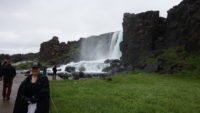
On the way to Pingvellir, we drove through misting rain, heavy rain, no rain, spots of sun, and back into rain again. When we actually got to Pingvellir, it was misting some, but we plowed on. The mist wasn’t enough to keep away the Icelandic midges, which came out in force, so we resorted back to putting our insect netting over our hats (to the positive comments of several people). We walked down a ravine right next to North America, and turned into a small viewing area, which is where it happened. We started getting real rain. And my touristic rock, Meredith, started to crack. She looked sad, and when I asked her about it, she said she had hoped the rain would hold off, and she was discouraged. Rain. Midges. Continents drifting. It can be too much.
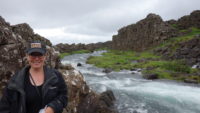
Happily, she hung in there, because in a few minutes, the rain stopped, and much later the sun even came out occasionally. The midges would disappear if you walked into the wind, and otherwise, the netting handled them, so that was good. The continents were still drifting, but Meredith overcame that one.
We wandered all over the paths of the valley, visiting two waterfalls on the river that falls into the valley. We walked next to the cliff face and visited the best-guess site of the Alpingi. We peered into windows of the small parish church and looked around the headstones of the graveyard.
The only downside to the morning was steps – after all the climbing we have done, we were tripped up on rock steps in the park. Meredith actually skinned one knee, and I just managed to catch myself when I tripped later. Constant vigilance is required in Iceland!
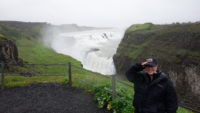
After a quick stop for a novel thing called “lunch,” at which we actually ate food not at breakfast or at supper, we drove on to Gullfoss, a huge waterfall at the far end of the Golden Circle, and from which the drive gets its name (Gullfoss means “Golden Waterfall”). Gullfoss is an impressive waterfall, even to people who have seen many waterfalls over the last two weeks. It’s a two-stage waterfall, with a thirty-five-foot upper drop down an angled rock face, before a seventy-foot drop into a canyon below, which is at an unusual ninety-degree angle to the falls (like an “L”). Most canyons just extend straight off the falls.
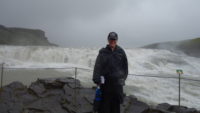 The area is well developed for tourists, with boardwalks for much of the area, and an upper and a lower viewing deck. You can also walk out past the boardwalk to stand on rocks looking right at the upper falls and right down into the lower falls. You do get soaked from the lower spray when you do this, but that almost didn’t matter today, as the rain came back for us at this stop. By the time we did both platforms and walked out to the rocky area, my pants were soaked, and I was getting cold from the eighteen-mph winds. Don’t get me wrong – Gullfoss is an amazing sight, and we stayed for some time, but by the time I got back to the car, I decided it was better to dig in the trunk for a pair of pants that I had already worn and retired for the trip than to try to get the pair I was wearing dry.
The area is well developed for tourists, with boardwalks for much of the area, and an upper and a lower viewing deck. You can also walk out past the boardwalk to stand on rocks looking right at the upper falls and right down into the lower falls. You do get soaked from the lower spray when you do this, but that almost didn’t matter today, as the rain came back for us at this stop. By the time we did both platforms and walked out to the rocky area, my pants were soaked, and I was getting cold from the eighteen-mph winds. Don’t get me wrong – Gullfoss is an amazing sight, and we stayed for some time, but by the time I got back to the car, I decided it was better to dig in the trunk for a pair of pants that I had already worn and retired for the trip than to try to get the pair I was wearing dry.
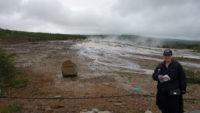 The rain again more or less stopped at our final sight of the day – the Geysir geothermal field. This is an area of boiling or near-boiling water that actually forms scalding-hot streams. That was new to me. It also houses Geysir, the original… geyser. It is no longer very active, but it was the first geyser that Europeans became aware of. Now, the geyser nearby, Strokkur, gets all the tourist love as it erupts in a spray of water every ten minutes or so.
The rain again more or less stopped at our final sight of the day – the Geysir geothermal field. This is an area of boiling or near-boiling water that actually forms scalding-hot streams. That was new to me. It also houses Geysir, the original… geyser. It is no longer very active, but it was the first geyser that Europeans became aware of. Now, the geyser nearby, Strokkur, gets all the tourist love as it erupts in a spray of water every ten minutes or so.
It is a very bizarre thing to see stunningly clear water that your experience tells you is cool and refreshing, while your eyes and brain are screaming at you to stay away from the steaming cauldron. To drive the point home, the “welcome” sign to the park reminds you the nearest hospital is sixty-two kilometers away.
 We looked around at all the pools, and then took a path up to an overlook. Along the way, we passed a perfectly still pool with no steam, but labeled as 80-100 degrees Celsius. The spring next to it was actually boiling actively. As we crested the rise of the path, we were greeted with a view of a large green valley with a small river and multiple horses grazing. It was lovely, and unexpected, since the area we had just walked through mostly only supported grass away from the water pools. We got to the main lookout area, and enjoyed the view in all directions for as long as we could take the strong and cold wind.
We looked around at all the pools, and then took a path up to an overlook. Along the way, we passed a perfectly still pool with no steam, but labeled as 80-100 degrees Celsius. The spring next to it was actually boiling actively. As we crested the rise of the path, we were greeted with a view of a large green valley with a small river and multiple horses grazing. It was lovely, and unexpected, since the area we had just walked through mostly only supported grass away from the water pools. We got to the main lookout area, and enjoyed the view in all directions for as long as we could take the strong and cold wind.
We finished our visit to the geothermal park by standing with a group of other tourists to see Strokkur go off. It obliged nicely, with a huge bubble forming on the surface before exploding a large amount of water into the air. I think we all paused for a second when it looked as if the plume might drift our way, but the wind drove it back.
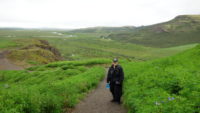 There are other things that can be done on the Golden Circle, but it was 5:30, so we headed back to our hotel area to grab some food and settle in for the night. Food and rest often act as a good cement for all of our touristic cracks.
There are other things that can be done on the Golden Circle, but it was 5:30, so we headed back to our hotel area to grab some food and settle in for the night. Food and rest often act as a good cement for all of our touristic cracks.